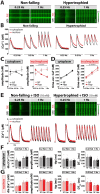Loss of autophagy protein ATG5 impairs cardiac capacity in mice and humans through diminishing mitochondrial abundance and disrupting Ca2+ cycling
- PMID: 33752242
- PMCID: PMC9074988
- DOI: 10.1093/cvr/cvab112
Loss of autophagy protein ATG5 impairs cardiac capacity in mice and humans through diminishing mitochondrial abundance and disrupting Ca2+ cycling
Abstract
Aims: Autophagy protects against the development of cardiac hypertrophy and failure. While aberrant Ca2+ handling promotes myocardial remodelling and contributes to contractile dysfunction, the role of autophagy in maintaining Ca2+ homeostasis remains elusive. Here, we examined whether Atg5 deficiency-mediated autophagy promotes early changes in subcellular Ca2+ handling in ventricular cardiomyocytes, and whether those alterations associate with compromised cardiac reserve capacity, which commonly precedes the onset of heart failure.
Methods and results: RT-qPCR and immunoblotting demonstrated reduced Atg5 gene and protein expression and decreased abundancy of autophagy markers in hypertrophied and failing human hearts. The function of ATG5 was examined using cardiomyocyte-specific Atg5-knockout mice (Atg5-/-). Before manifesting cardiac dysfunction, Atg5-/- mice showed compromised cardiac reserve in response to β-adrenergic stimulation. Consequently, effort intolerance and maximal oxygen consumption were reduced during treadmill-based exercise tolerance testing. Mechanistically, cellular imaging revealed that Atg5 deprivation did not alter spatial and functional organization of intracellular Ca2+ stores or affect Ca2+ cycling in response to slow pacing or upon acute isoprenaline administration. However, high-frequency stimulation exposed stunted amplitude of Ca2+ transients, augmented nucleoplasmic Ca2+ load, and increased CaMKII activity, especially in the nuclear region of hypertrophied Atg5-/- cardiomyocytes. These changes in Ca2+ cycling were recapitulated in hypertrophied human cardiomyocytes. Finally, ultrastructural analysis revealed accumulation of mitochondria with reduced volume and size distribution, meanwhile functional measurements showed impaired redox balance in Atg5-/- cardiomyocytes, implying energetic unsustainability due to overcompensation of single mitochondria, particularly under increased workload.
Conclusion: Loss of cardiac Atg5-dependent autophagy reduces mitochondrial abundance and causes subtle alterations in subcellular Ca2+ cycling upon increased workload in mice. Autophagy-related impairment of Ca2+ handling is progressively worsened by β-adrenergic signalling in ventricular cardiomyocytes, thereby leading to energetic exhaustion and compromised cardiac reserve.
Keywords: Autophagy; Beta-adrenergic signalling; Calcium; Cardiomyocytes; Mitochondria.
© The Author(s) 2021. Published by Oxford University Press on behalf of the European Society of Cardiology.
Figures








Comment in
-
Regulation of calcium handling by autophagy: a novel mechanism limiting cardiac hypertrophy and dysfunction?Cardiovasc Res. 2022 May 6;118(6):1377-1379. doi: 10.1093/cvr/cvac035. Cardiovasc Res. 2022. PMID: 35425968 No abstract available.
Similar articles
-
Beta-Adrenoceptor Stimulation Reveals Ca2+ Waves and Sarcoplasmic Reticulum Ca2+ Depletion in Left Ventricular Cardiomyocytes from Post-Infarction Rats with and without Heart Failure.PLoS One. 2016 Apr 20;11(4):e0153887. doi: 10.1371/journal.pone.0153887. eCollection 2016. PLoS One. 2016. PMID: 27096943 Free PMC article.
-
Early remodeling of perinuclear Ca2+ stores and nucleoplasmic Ca2+ signaling during the development of hypertrophy and heart failure.Circulation. 2014 Jul 15;130(3):244-55. doi: 10.1161/CIRCULATIONAHA.114.008927. Epub 2014 Jun 13. Circulation. 2014. PMID: 24928680 Free PMC article.
-
TXNIP/Redd1 signalling and excessive autophagy: a novel mechanism of myocardial ischaemia/reperfusion injury in mice.Cardiovasc Res. 2020 Mar 1;116(3):645-657. doi: 10.1093/cvr/cvz152. Cardiovasc Res. 2020. PMID: 31241142
-
Loss of AKAP150 promotes pathological remodelling and heart failure propensity by disrupting calcium cycling and contractile reserve.Cardiovasc Res. 2017 Feb;113(2):147-159. doi: 10.1093/cvr/cvw221. Epub 2016 Nov 17. Cardiovasc Res. 2017. PMID: 27856611 Free PMC article.
-
Targeting Ca2+ cycling proteins and the action potential in heart failure by gene transfer.Basic Res Cardiol. 2002;97 Suppl 1:I136-45. doi: 10.1007/s003950200042. Basic Res Cardiol. 2002. PMID: 12479247 Review.
Cited by
-
Autophagy in striated muscle diseases.Front Cardiovasc Med. 2022 Oct 13;9:1000067. doi: 10.3389/fcvm.2022.1000067. eCollection 2022. Front Cardiovasc Med. 2022. PMID: 36312227 Free PMC article. Review.
-
Nuclear Calcium in Cardiac (Patho)Physiology: Small Compartment, Big Impact.Biomedicines. 2023 Mar 21;11(3):960. doi: 10.3390/biomedicines11030960. Biomedicines. 2023. PMID: 36979939 Free PMC article. Review.
-
Knockdown ATG5 gene by rAAV9 alleviates doxorubicin-induced cardiac toxicity by inhibiting GATA4 autophagic degradation.Front Pharmacol. 2025 Jan 27;15:1496380. doi: 10.3389/fphar.2024.1496380. eCollection 2024. Front Pharmacol. 2025. PMID: 39931517 Free PMC article.
-
Hallmarks of cardiovascular ageing.Nat Rev Cardiol. 2023 Nov;20(11):754-777. doi: 10.1038/s41569-023-00881-3. Epub 2023 May 16. Nat Rev Cardiol. 2023. PMID: 37193857 Review.
-
Large animal models of pressure overload-induced cardiac left ventricular hypertrophy to study remodelling of the human heart with aortic stenosis.Cardiovasc Res. 2024 Apr 30;120(5):461-475. doi: 10.1093/cvr/cvae045. Cardiovasc Res. 2024. PMID: 38428029 Free PMC article. Review.
References
-
- Abdellatif M, Sedej S, Carmona-Gutierrez D, Madeo F, Kroemer G. Autophagy in cardiovascular aging. Circ Res 2018;123:803–824. - PubMed
-
- Nakai A, Yamaguchi O, Takeda T, Higuchi Y, Hikoso S, Taniike M, Omiya S, Mizote I, Matsumura Y, Asahi M, Nishida K, Hori M, Mizushima N, Otsu K. The role of autophagy in cardiomyocytes in the basal state and in response to hemodynamic stress. Nat Med 2007;13:619–624. - PubMed
-
- Eisenberg T, Abdellatif M, Schroeder S, Primessnig U, Stekovic S, Pendl T, Harger A, Schipke J, Zimmermann A, Schmidt A, Tong M, Ruckenstuhl C, Dammbrueck C, Gross AS, Herbst V, Magnes C, Trausinger G, Narath S, Meinitzer A, Hu Z, Kirsch A, Eller K, Carmona-Gutierrez D, Büttner S, Pietrocola F, Knittelfelder O, Schrepfer E, Rockenfeller P, Simonini C, Rahn A, Horsch M, Moreth K, Beckers J, Fuchs H, Gailus-Durner V, Neff F, Janik D, Rathkolb B, Rozman J, de Angelis MH, Moustafa T, Haemmerle G, Mayr M, Willeit P, von Frieling-Salewsky M, Pieske B, Scorrano L, Pieber T, Pechlaner R, Willeit J, Sigrist SJ, Linke WA, Mühlfeld C, Sadoshima J, Dengjel J, Kiechl S, Kroemer G, Sedej S, Madeo F. Cardioprotection and lifespan extension by the natural polyamine spermidine. Nat Med 2016;22:1428–1438. - PMC - PubMed
-
- Taneike M, Yamaguchi O, Nakai A, Hikoso S, Takeda T, Mizote I, Oka T, Tamai T, Oyabu J, Murakawa T, Nishida K, Shimizu T, Hori M, Komuro I, Takuji Shirasawa TS, Mizushima N, Otsu K. Inhibition of autophagy in the heart induces age-related cardiomyopathy. Autophagy 2010;6:600–606. - PubMed
MeSH terms
Substances
Grants and funding
LinkOut - more resources
Full Text Sources
Other Literature Sources
Molecular Biology Databases
Miscellaneous

